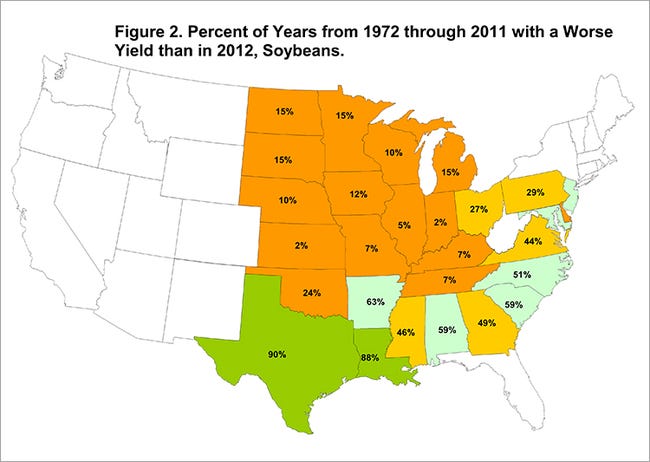August 14, 2012

On August 10th, the USDA released its first estimates of 2012 corn and soybean yields on a state level. As one would expect given the 2012 drought, many states are projected to have poor yields. Relative to trend yields from 1972 through 2011, 2012 corn yields are projected to be the worst in four states. The lowest corn and soybean yields are located in or near the Midwest. Southern and eastern seaboard states have relatively higher yields.
Corn yields
Figure 1 shows a map giving a percentage for each state that USDA reported a yield in its August 10th report. This percentage indicates the percent of yields from 1972 through 2011 that are below the 2012 yield. For example, Illinois’ percentage is 5%. This indicates that 5% of the yields from 1972 through 2011 are below the 2012 yield in terms of percent deviations from trend. USDA projects Illinois’ 2012 yield at 116 bu. per acre. This 116 bu. yield is -30% of the 2012 trend yield of 164 bu. per acre (-30% = 116 bu. projected yield/164 bu. trend yield - 1). For Illinois, the 5% means that two-year has larger negative deviations than 2012: 1983 with a -32% deviation and 1988 with a -41% deviation.

Low yields are centered in the Midwest. The 2012 state yield is the worst yield from 1972 through 2011 for four states: Indiana, Kansas, Kentucky, and Missouri. Other major corn producing states with low yields are Illinois (5%), Iowa (7%), North Dakota (10%), South Dakota (10%), Minnesota (17%), and Nebraska (20%).
States in the southern U.S. and along the eastern seaboard are projected to have relatively good yields. These states include Texas (88%), Georgia (88%), South Carolina (83%), Louisiana (71%) and Virginia (59%).
Soybean yields
Similar to corn, low soybean yields are located in the Midwest (see Figure 2). Both Indiana and Kansas only have 2% of the years with larger negative deviations than 2012. Illinois has 5% of yields below 2012 yields, while Kentucky, Missouri, and Tennessee have 7% of years below 2012.

You May Also Like




